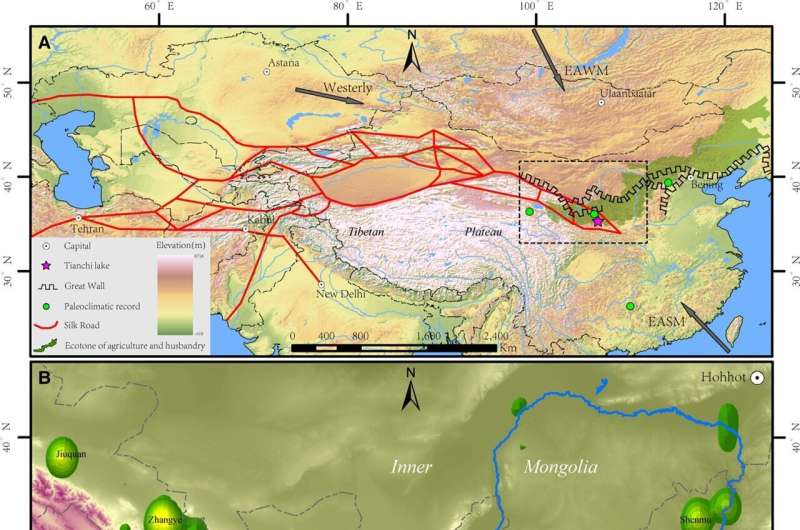Study finds fires of war overtook climate-controlled fires along the eastern Silk Road
Human activities such as intentional burning, agriculture, pastoralism, and metallurgy can affect the frequency of fire in an ecosystem. Guanghui Dong, Aifeng Zhou and colleagues investigated whether another typical human activity has influenced fire history in the areas along the Silk Road: war.
Their study is published in PNAS Nexus.
Fire was a commonly used weapon in ancient Chinese warfare. In the 5th century BCE, military strategist Sun Tzu, author of The Art of War, advised the use of fire against enemy troops and supplies. The authors measured black carbon, soot, and char in sediments from a core of Tianchi Lake, which represent 6,000 years of sediment deposition.
The authors calculated the spatial range of land that would have contributed fire-related particulate to the sediment using the potential source contribution function analysis, a method typically used to determine the source areas for contemporary pollution.
Fire was infrequent in the middle Holocene, but became more frequent in the late Holocene, as the climate became drier and flammable herbaceous vegetation spread. Then, 2,000 years ago, the fire frequency became decoupled from climate or vegetation.
On centennial timescales, fires during this period are synchronous with warfare, as recorded in the List of Wars in Historical China. From 2,000–400 years ago, warfare between different political powers may have been the dominant contributor to high-intensity fires in the area, according to the authors.
More information:
Shanjia Zhang et al, Warfare impact overtakes climate-controlled fires in the eastern Silk Roads since 2000 B.P., PNAS Nexus (2023). DOI: /10.1093/pnasnexus/pgad408 academic.oup.com/pnasnexus/art … 2/12/pgad408/7477228
Citation:
Study finds fires of war overtook climate-controlled fires along the eastern Silk Road (2023, December 19)
retrieved 19 December 2023
from https://phys.org/news/2023-12-war-overtook-climate-controlled-eastern-silk.html
This document is subject to copyright. Apart from any fair dealing for the purpose of private study or research, no
part may be reproduced without the written permission. The content is provided for information purposes only.

Human activities such as intentional burning, agriculture, pastoralism, and metallurgy can affect the frequency of fire in an ecosystem. Guanghui Dong, Aifeng Zhou and colleagues investigated whether another typical human activity has influenced fire history in the areas along the Silk Road: war.
Their study is published in PNAS Nexus.
Fire was a commonly used weapon in ancient Chinese warfare. In the 5th century BCE, military strategist Sun Tzu, author of The Art of War, advised the use of fire against enemy troops and supplies. The authors measured black carbon, soot, and char in sediments from a core of Tianchi Lake, which represent 6,000 years of sediment deposition.
The authors calculated the spatial range of land that would have contributed fire-related particulate to the sediment using the potential source contribution function analysis, a method typically used to determine the source areas for contemporary pollution.
Fire was infrequent in the middle Holocene, but became more frequent in the late Holocene, as the climate became drier and flammable herbaceous vegetation spread. Then, 2,000 years ago, the fire frequency became decoupled from climate or vegetation.
On centennial timescales, fires during this period are synchronous with warfare, as recorded in the List of Wars in Historical China. From 2,000–400 years ago, warfare between different political powers may have been the dominant contributor to high-intensity fires in the area, according to the authors.
More information:
Shanjia Zhang et al, Warfare impact overtakes climate-controlled fires in the eastern Silk Roads since 2000 B.P., PNAS Nexus (2023). DOI: /10.1093/pnasnexus/pgad408 academic.oup.com/pnasnexus/art … 2/12/pgad408/7477228
Citation:
Study finds fires of war overtook climate-controlled fires along the eastern Silk Road (2023, December 19)
retrieved 19 December 2023
from https://phys.org/news/2023-12-war-overtook-climate-controlled-eastern-silk.html
This document is subject to copyright. Apart from any fair dealing for the purpose of private study or research, no
part may be reproduced without the written permission. The content is provided for information purposes only.
